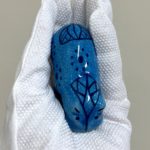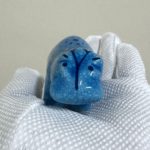
Replica ceramic blue hippopotamus from the museum handling box
My name is Lydia and I am a Chip In volunteer here at Blackburn Museum.
I have recently been running the object handling table here at the museum during the school holidays. One of the most popular handling boxes has been the Egyptian box which contains both real items from ancient Egypt and replicas of popular items from the period.
The box contains lots of interesting items, but this replica blue hippo in particular has taken my interest and I have spent a bit of time researching the history and what it symbolises.
In ancient Egypt many animals, from cats to scarab beetles to hippopotamuses, were believed to be symbols and have featured heavily in everyday life and religious worship. However, the ancient Egyptians have had a complicated relationship with hippos in particular, both fearing them and admiring them as symbols of life and strength. For centuries hippopotamuses had lived near the River Nile in Egypt and were a symbol used by the ancient Egyptians to understand the world around them. Hippo’s have long been linked with the Gods and were seen as a symbol of strength and power, even leading Pharaohs and kings to have portraits drawn of them fighting hippos to show their courage.
For the ancient Egyptians the hippo was strongly linked to mythology and was connected to several of the Egyptian Gods. Taweret, meaning ‘she who is great’ is the most popular Goddess to be represented by the hippo as she was seen to be strong and powerful. She was often worshipped as a symbol of motherhood and is often depicted as a pregnant woman with the head of a hippo. Taweret was also seen as a protective guise wielding a knife on apotropaic wands, mostly found in late middle kingdom burials, the wands are believed to have been seen as a form of protection during birth and early in life and often found in burial tombs to symbolise rebirth.
Another God associated with the hippo is Ammit, which means ‘soul-eater’ or ‘devourer’, who is connected to the time of judgement and believed to be part hippo, lion and crocodile. Ammit was believed to consume the hearts of those who had lived an unjust life, after their hearts had been weighed against a feather. The ancient Egyptians are not known to have worshipped Ammit, but rather feared and respected her, as she reminded them of the principles of Ma’at, order, balance, justice.
Male hippos were often seen as a destructive force and in the new kingdom they became tied to Set, also known as Seth, who was the Egyptian God of chaos and destruction and believed to be one of the first Gods created by the union of Geb (Earth). Set was seen as an evil God for the murder of Osiris and though often depicted as a red-haired beast with a forked tail he was also represented by the hippopotamus, which may have influenced the belief that male hippos were associated with evil. This mythology may have influenced the ancient Egyptians to create a ceremony in which Kings would ritually kill hippos, to represent the overthrowing of Set and therefore chaos. On the other hand, female hippos were highly respected and seen as a protective motherly figure, reflected through their association to god’s like Taweret.
The river Nile, which was cited as the source of life, has also led Hippos to become associated with life and rebirth for the ancient Egyptians. Figurines of small blue hippos were placed in tombs alongside other burial objects. These were often made out of ceramic faience and glazed in the colour blue as this was the colour of the Nile. To them the bright blue symbolised life and when placed in tombs it was believed to give life to the deceased. Although, as the ancient Egyptians also feared these creatures and believed they could magically come alive the legs of these figures would purposely be broken to eliminate the hippo’s destructive power and protect the dead.

The hippo’s decorative design and patterns
The body of most hippopotamus figures like ours have been decorated with flowers, leaves or butterflies to represent the hippo’s natural habitat. For example, the lotus flower being a common symbol as the flower opens in the morning and closes at night reflecting the eternal cycle of death and rebirth. The faience was made from common materials such as quartz, alkaline salts, lime and mineral based colorants which is what allowed the ancient Egyptians to create a variety of objects glazed in a shiny bright blue such as trinkets, jewellery, ritual objects and the sculptures. You can see other blue faience examples up in the museum’s Egyptian Gallery and many other objects like the hippo linked to life and cultural beliefs in ancient Egypt.
Looking to explore the ancient Egyptian period in schools or with your children? Get in touch with us to find out more about our schools offer and handling boxes, watch our kid friendly YouTube videos made with Huckleberry Films here and make sure to follow us on social media to find out about our school holiday events and handling table pop-ups.

